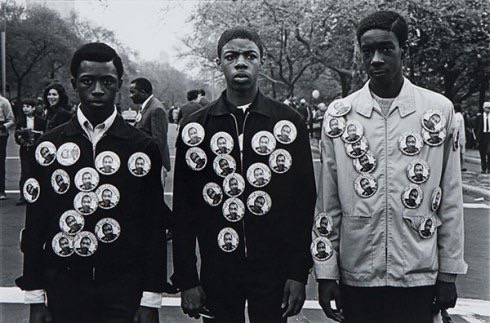Tartan is a fabric of rebellion, and it has long held appeal with those who consider themselves to be outsiders.
In 1745, the Scottish House of Stuart led the Jacobite Army in an unsuccessful attempt to seize the British throne from King George II. Following the uprising, a series of laws were enacted to subdue the fiercely independent Jacobites. The Dress Act of 1746, one of these laws, made tartan dress illegal in the United Kingdom. Anyone who wore tartan or other signifiers of traditional Scottish dress could face fines, imprisonment or exile.
However, The Dress Act of 1746 seemed only to strengthen the power of tartan. People across the United Kingdom began wearing full tartan outfits in defiance of the British government. Artists painted influential figures dressed in tartan but left their paintings unsigned, fearing that they would be punished for these public displays of dissent. Tartan became a signifier of anti-establishment attitudes, a very punk choice in the 18th century.
In 1974, Vivienne Westwood and Malcolm McLaren opened their boutique SEX to cater to the burgeoning Punk rock scene in London. Westwood stocked the shop with every type of plaid imaginable, and soon the Sex Pistols were singing out against the British government in full tartan suits, just like the Jacobites nearly two hundred years before them.

This 1993 wedding dress by Vivienne Westwood is a vision of tartan excess, crafted from yards of plaid silk that cascade over a bloom of tulle in coordinating colours. Though the concept of a tartan wedding dress is unorthodox, it is not purely a whim of Westwood’s wild imagination and is rooted deeply in the history of Scottish fashion. The Isabella MacTavish Fraser Wedding Gown provides an example – a rare one, albeit – of a tartan wedding gown dating back to 1785. Though many details about the spectacular Isabella MacTavish Fraser Wedding Gown remain shrouded in mystery, the tartan of the dress can be identified as one woven between 1775 and 1784. This means that it was likely created while The Dress Act of 1746 was still in place, making this wedding dress an illegal creation.

The headpiece that accompanies Westwood’s dress makes reference to a traditional piece of women’s Highland dress known as the earasaid. The earasaid is a length of pleated fabric that would be wrapped around the head like a veil and affixed at the waist. Although there is little information available on women’s dress in the Highlands before the turn of the 18th century, some historical evidence suggests that the wearing of the earasaid could date back to Pictish times. By the 1800s, written accounts and sketches of working-class women in earasaids were circulated across the United Kingdom, solidifying the trend as a hallmark of Scottish brides, even though the accuracy of these accounts remains contestable. Westwood recalls the earasaid with her veil’s gentle pleats and billowing volume but elevates its humble origins by pairing it with a regal gown of matching plaid.

In a thoroughly contemporary interpretation of bridal traditions, Kate Moss first wore this gown down the runway at Westwood’s Autumn/Winter 1993 show with the bodice lowered to reveal one of her breasts. Preserving her modesty was a handful of flowers that once again harken back to tartan’s origins. Moss’s bouquet is studded with white roses, the symbol of the Jacobite army. Women participants in the Jacobite rebellion would often have their portraits painted with white roses tucked into the bodices of their dresses and their hair to signify their allegiance to the cause.

The bride who selects this dress to wear on her wedding day, likely one of the most publicly visible events of her life, chooses consciously not to perform the societal role expected of her. This wedding gown eschews the notion of brides dressing in virginal white, and it recalls a raucous national identity far more than a standard wifely one. With its earasaid and Jacobite references, this dress pays homage to the oft-overlooked women participants in the radical movements of Scottish history.
Westwood is one of the foundational contributors to tartan’s punk reputation, but she has also worked to ensure the medium’s longevity beyond the punk rock movement and, almost certainly conscious of her status as an Englishwoman, to emphasise its unique Scottish heritage. This dress is cut from MacAndreas tartan, a sett of tartan created by Westwood as a romantic tribute to her husband and collaborator Andreas Kronthaler. MacAndreas tartan is now officially listed in the Scottish Register of Tartans. Westwood has also created many of her tartan garments in accordance with the Harris Tweed Act, a 1993 Act of Parliament which seeks to protect and promote the traditional methods of woollen fabric weaving in Scotland.
From the Dress act of 1746 to the Harris Tweed Act of 1993, the lawmaking that surrounds tartan begs the question: why is tartan something institutions feel the need to control? Is it a dangerously influential pattern that incites revolt across centuries? Is it a precious national resource that must be protected at all costs? For the bride who dons a tartan wedding dress, one thing is certain. Tartan is a testament to fierce individuality and national history, suitable to dress herself in for one of the most sacred days of her life.
By Ruby Redstone
Sources:
Faiers, Jonathan. Tartan. London: Bloomsbury, 2008
Inverness Museum and Art Gallery online. ‘The Isabella Project’. Published February 2020.https://www.highlifehighland.com/inverness-museum-and-art-gallery/the-isabella-project/
MacDonald, Peter Eslea. ‘Musing on the Arisaid and Other Female Dress.’ Scottish Tartans online. Published 2016.https://www.scottishtartans.co.uk/Musings_on_the_arisaid_and_other_female_dress.pdf
Maspero, Ida. ‘Tartan Romance,’ National Museums Scotland online. Published 26 May 2019. https://blog.nms.ac.uk/2019/05/26/tartan-romance/
Scottish Tartans Authority. ‘Tartan and the Dress Act of 1746.’ Accessed 28 February 2021. http://www.tartansauthority.com/resources/archives/the-archives/scobie/tartan-and-the-dress-act-of-1746/
The Scottish Register of Tartans. ‘Westwood MacAndreas.’ Published 1 January 1993. https://www.tartanregister.gov.uk/tartanDetails?ref=5530
V&A online. ‘Vivienne Westwood: A taste for the past’. Last accessed 15 February 2021. https://www.vam.ac.uk/articles/vivienne-westwood-a-taste-for-the-past
Watt, Patrick and Rosie Waine. Wild and Majestic: Romantic Visions of Scotland. Edinburgh: National Museum of Scotland, 2019




